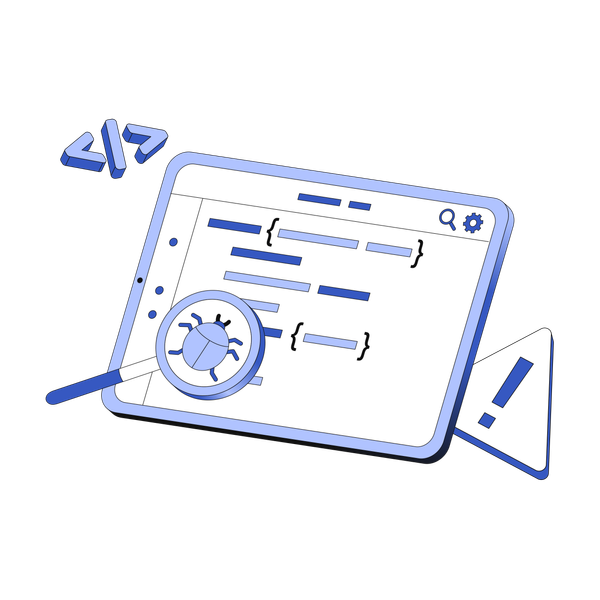7 Key Content Optimization Factors for Organic Social Media Growth in Game Marketing
Discover how to grow your indie game’s wishlists organically with a data-driven social media strategy. Learn the best content types, emotional triggers, audience targeting, and posting times to maximize engagement.

With over 19,000 games being released each year on Steam alone, game developers must create and execute a marketing strategy to capture the attention of their audience. One of the most cost-effective methods of doing this is by building an organic social media strategy.
An organic social strategy can power your wishlist addition growth anywhere from 10 to 300 wishlists a day! And if you launch your storefront on Steam, Itch, Epic, or another service, that consistent growth over a year or two can lead to anywhere between 3,650 to 100,000+ wishlist additions for a launch.
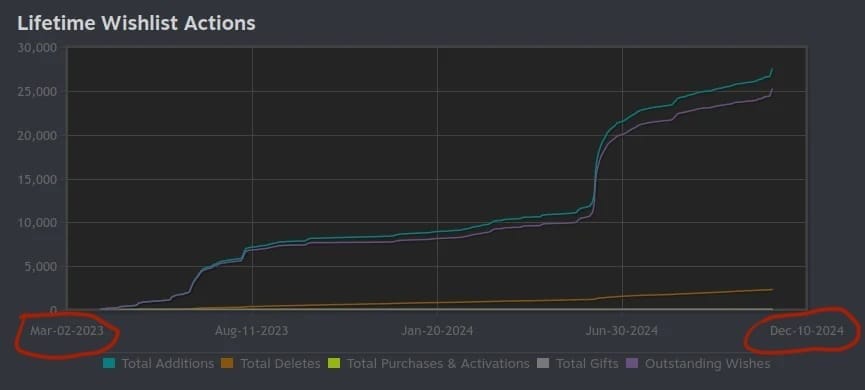
At Glitch, we focus heavly on a data-driven approach to marketing, and in many articles, we have pointed out that wishlist growth is a long-term strategy for your game that works better the earlier you start. In this article, we are going to cover “Content Optimization Factors” or “Social Media Performance Variables,” which are:
- Type of Content
- Emotional Tone
- Audience Targeting
- Timing
- Media Type
- Call to Action
- Platform Best Practices
By learning about these different optimization variables, you will be able to correctly execute a repeatable growth strategy for your game. We are going to use real data from our clients who utilize our social media services to demonstrate key insights for your own efforts.
We will have fun pop quizzes in this article.
Setting Expectations
First, we need to set up some expectations about developing a social media strategy.
- Requires 1 Month: The biggest mistake we see with developers is giving up after a week. You will need to dedicate at least one month to developing this strategy, and you will see why throughout the article.
- Data-Driven Only, No Feelings: We often hear a developer saying, “I do not feel my audience will like this.” This can create huge obstacles to successful execution. Data is king; collect and use data in your decision-making. We will show you how below.
- Experimentation Mindset and Risk: Remember in middle school or high school how you had to form a hypothesis and conduct an experiment to prove or disprove it? Use that same mindset here. You will experience both failures and successes, but that is the path to getting the best results. Take risks!
- This Will Not Be Quick: One of the questions we always get is, “How can I quickly build my social presence?” Short of buying followers and engagement (which we recommend you do not do), this is not a quick process—it takes time and consistency.
- Have All Your Digital Assets Ready: Make sure that all your socials are fully branded. Have a linking system, such as Linktree, that connects everything. Have your store pages up and ready. You do not need the perfect storefront page.
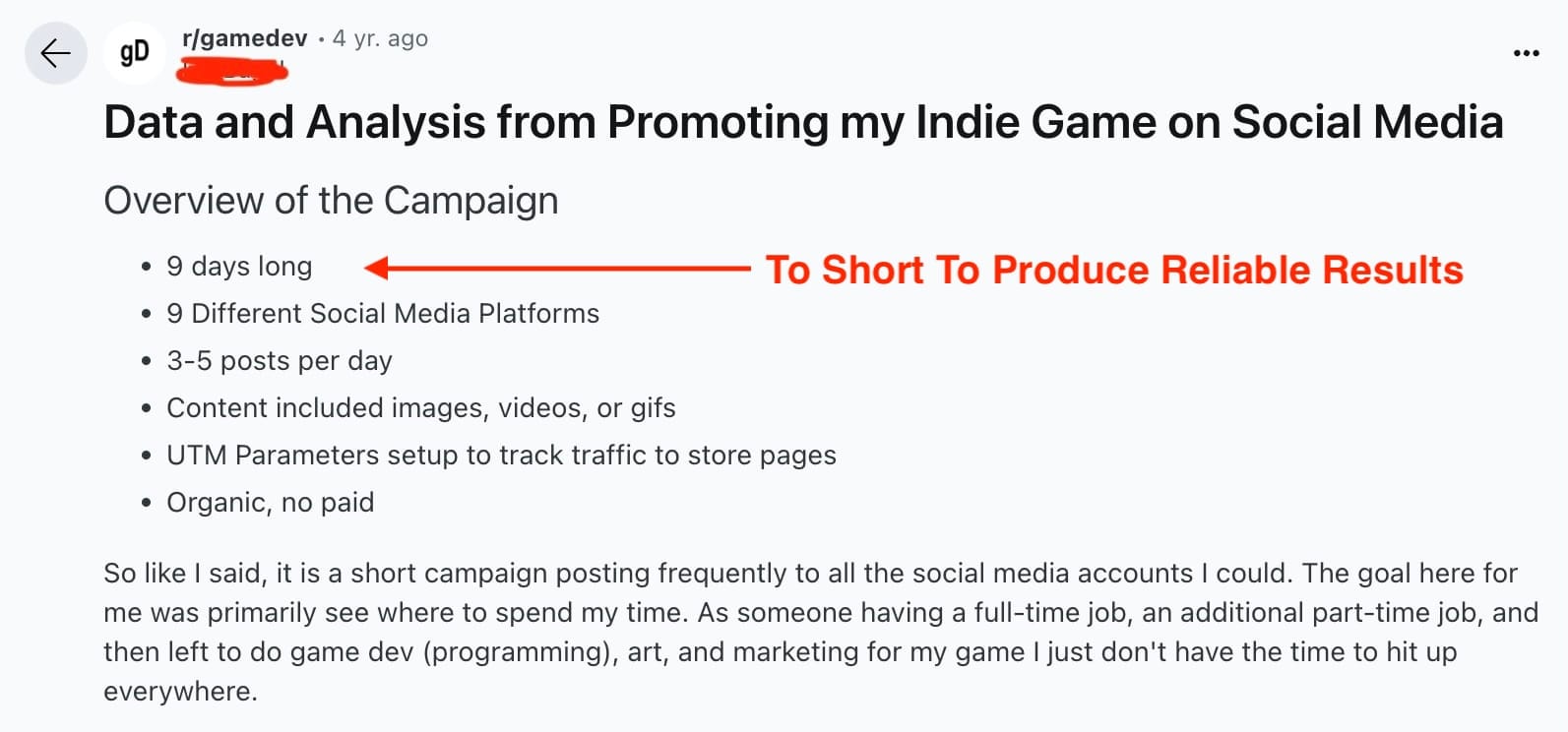
With these expectations in mind, we can begin to explore the seven optimization factors and variables for your social media, and then discuss how to tie them all into testing.
1) Type of Post
The first area we are going to cover is the type of social media post you can create. For gaming, there are several kinds of posts, which include but are not limited to:
- Trailers: Action-packed trailers that show the best images or scenes from the game. While they can be highly engaging, they are expensive and time-consuming to produce consistently.
- Devlogs: These are not necessarily in-depth explanations of complicated developer insights. The most effective devlogs for marketing are often under one minute, showing quick snippets of game creation or “behind the scenes” looks.
- Artwork: Showcase your game’s artwork or cool images that appeal to your audience.
- Before and After: If you have updated old assets or mechanics, show the evolution from the original version to the final version. These can be short videos (under a minute) or images.
- Gameplay: Highlight exciting scenes or brief, dynamic gameplay segments.
- Team Interviews: Feature conversations with various team members talking about the game’s development, the vision behind it, or upcoming features.
- Fan Videos: If you have allowed early access to fans or content creators, you can edit or “chop up” their footage to share with your own audience.
- Positive Testimonials: If you have positive testimonials, you can screenshot or excerpt them to help promote your game.
- Timed Deals: Giveaways, special offers, and other promotional opportunities that are time-based.
- Users Choice: Giving users a prompt to reply with a limited number of choices.
Each post type will produce different levels of results. Here is data from one our clients’ post types and how the post type effects the views, comments, engagement, and other metrics for the game.

As you can see, timed content posts perform well in generating views. You have to learn which kinds of content yield the best results for your game.
Pop Quiz: Use the data above. You are in phase where you want to build community. Community is often measured with engagement like comments. From the types above, what kind of content should you be creating to maximize your community engagement and growth?
2) Emotional Tone
The next variable to consider when creating your post is its emotional tone. At Glitch, we categorize posts into 24 possible emotional tones:
- Amusement – A sense of enjoyment and lighthearted pleasure, often in response to humor.
- Anger – A strong feeling of displeasure or hostility in reaction to perceived injustice or wrongdoing.
- Confidence/Pride – A sense of satisfaction in one’s achievements or abilities, often linked to self-assurance.
- Confusion – A state of uncertainty or lack of clarity about a situation or information.
- Contempt – A feeling of superiority and disdain toward something or someone perceived as worthless or inferior.
- Cute/Kama Muta – A warm, heart-touching feeling often triggered by seeing something adorable or emotionally moving.
- Disgust – A feeling of revulsion or strong disapproval toward something considered offensive or unpleasant.
- Embarrassment – A self-conscious feeling of discomfort due to awkwardness or social missteps.
- Empathic Pain – A deep emotional reaction to another person’s suffering, leading to shared distress.
- Envy – A feeling of resentment or longing caused by wanting what someone else has.
- Excitement – A state of heightened anticipation and enthusiasm for something pleasurable or significant.
- Fear – An emotional response to perceived danger or threat, triggering anxiety and caution.
- Gratitude – A sense of appreciation and thankfulness toward someone or something.
- Happiness – A state of positive emotions and contentment, often accompanied by joy.
- Hate – An intense feeling of animosity or aversion toward a person, group, or idea.
- Love – A deep emotional connection and affection toward a person, idea, or thing.
- Nostalgia – A sentimental longing or affection for the past, often associated with happy memories.
- Relief – A feeling of reassurance and relaxation following the removal of stress or fear.
- Sadness – A feeling of sorrow or unhappiness, often in response to loss or disappointment.
- Sexual Attraction – A feeling of physical desire and romantic interest toward someone.
- Surprise – A sudden emotional reaction to an unexpected event, which can be positive or negative.
- Wonder – A feeling of awe and fascination in response to something extraordinary or mysterious.
- Guilt/Shame – A distressing feeling of remorse or embarrassment due to perceived wrongdoing or failure.
- Sexual – Content that has a sexual overtone or is explicitly sexual.
Similar to the type of post, you want to understand which emotions most appeal to your audience.Here is more data from one of our client's post types:

Monitor your views, comments, and other important engagement metrics to see which emotional tones perform best.
Pop Quiz: Use the data above. You are in the phase where you want to maximize brand awareness, and just get people to know that your game exists, you will focus on conversions later. What kind of emotional appeal should your content have to maximize brand awareness?
3) Audience Targeting
Your content needs to correctly target an interested audience—one that will give you the most awareness, help grow your following, and eventually convert into users for your game. Different platforms have different ways of doing this.
Instagram, TikTok, X/Twitter, LinkedIn, and YouTube (to a limited extent) use hashtags so people can discover your content. You should be researching and testing which hashtags work the best for your game. Analyze those hashtags in detail to see if they are yielding results.
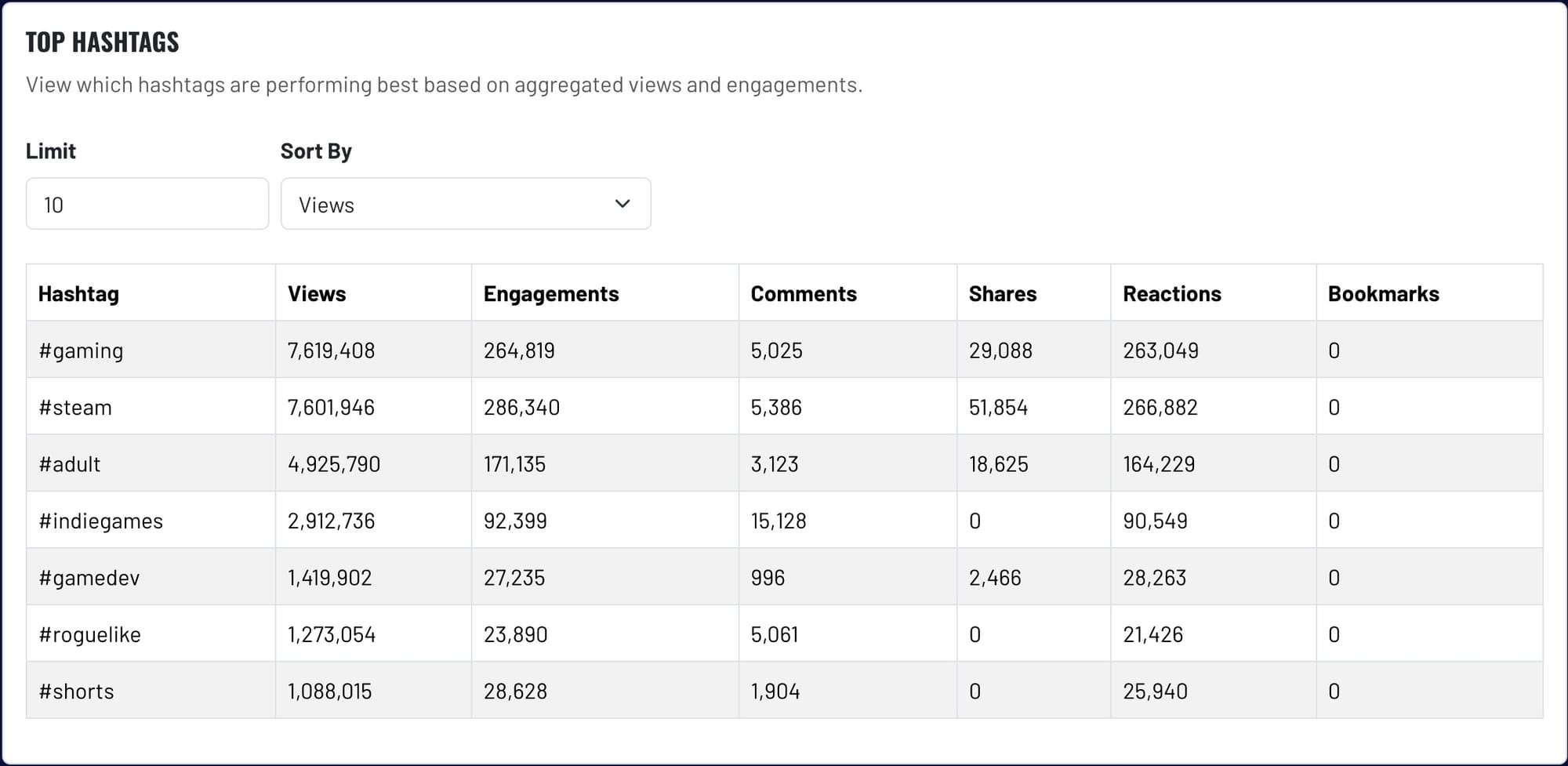
Other platforms like Reddit, Facebook, Snapchat, and Pinterest use different targeting systems for your game. For example, Reddit is all about finding the right subreddit for your content and then tailoring the post to that specific community. The key is to test and learn what works best for each platform for your game.
4) Timing
Next, for your content optimization, we want to understand the timing of your posts: both the day of the week and the time of day. Take a look at this chart below from our app.
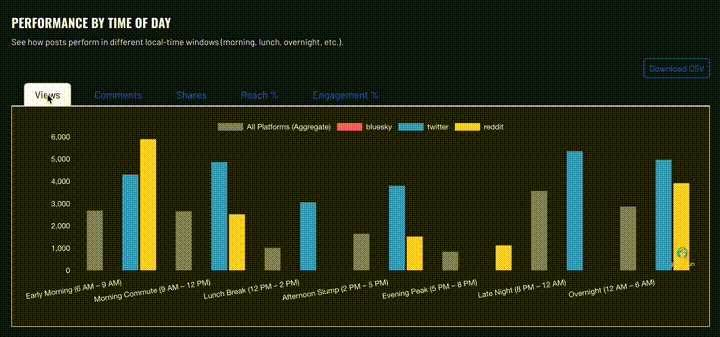
We break the times down as follows:
- Early Morning (6 AM – 9 AM) → People often check their phones after waking up.
- Morning Commute (9 AM – 12 PM) → Browsing during travel or breaks.
- Lunch Break (12 PM – 2 PM) → Increased scrolling during lunchtime.
- Afternoon Slump (2 PM – 5 PM) → Less activity, but still some engagement.
- Evening Peak (5 PM – 8 PM) → Prime time for social media use.
- Late Night (8 PM – 12 AM) → High engagement from night owls.
- Overnight (12 AM – 6 AM) → Minimal activity, but potential for a global audience.
You will have to learn what times work best for your game’s promotion and generate the highest response. Then consider the days of the week, as shown in the chart you might be using.
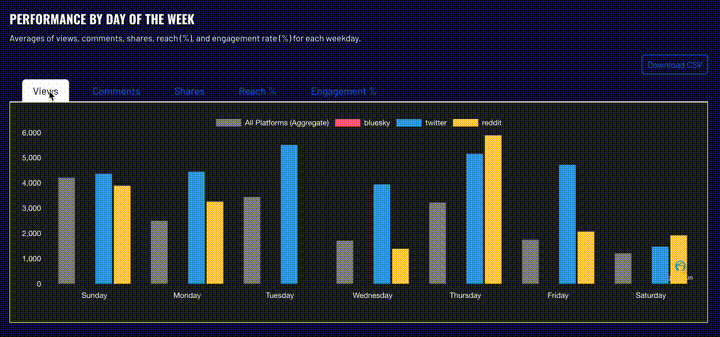
When promoting your content on social media, your game will have its own “best days” and days when engagement declines.
Pop Quiz: If the charts above represented your game, and you want to announce a launch. According to the data, what would be the best day/time to promote on each platform.
5) Media Type
Next in our optimization strategy is the type of media you use, which typically includes images, videos, and GIFs. Each media type will deliver its own engagement metrics. Here is two images about distribution vs engagement for media type from one of our clients.

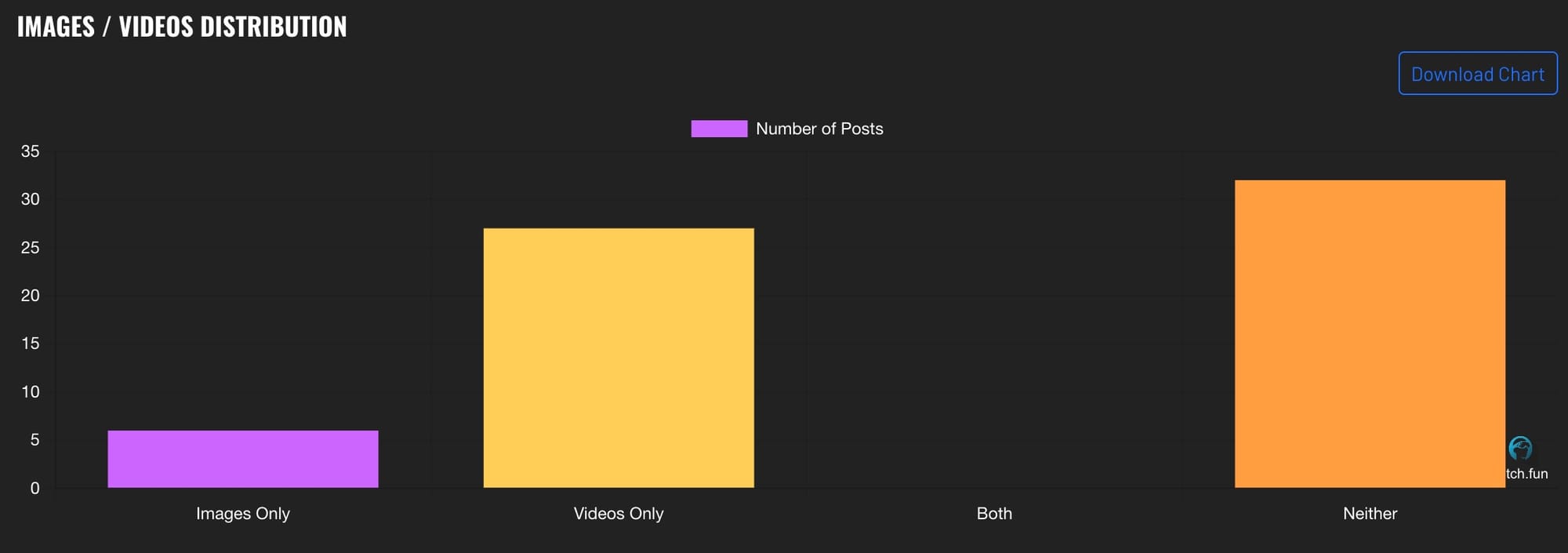
Try to understand which media type resonates most with your audience. Furthermore, you should test if using a desktop-oriented aspect ratio (e.g., 16:9) versus a mobile-friendly vertical orientation (e.g., 9:16) has any impact on engagement.
Another variable to factor in with video is length. It has ben well established that short form videos are the best for consumers, with videos over 30 seconds losing a consumer's interest. Factor in your video length with your marketing.
Pop Quiz: Based on the data above and pretending this your game, looking at the number of posts created for a content type and then comparing that to it's engagement, would you make any changes to your content strategy and why?
6) Call to Action
Whenever you post content, include a clear CTA (Call to Action). For example:
- “Wishlist now!”
- “Download on Epic!”
- “Donate on Kickstarter!”
- “Invest on Republic!”

Whatever your goal is, make sure you explicitly tell users what you want them to do. Also, test out which calls to action get you the best results.
7) Platform Best Practices
Finally, each social media platform has its own set of rules. For example, on LinkedIn, if you post more than twice a day, the algorithm may suppress your content. On YouTube, clickbait titles can hurt your future exposure. On TikTok, using the same hashtags too often can get you flagged as a bot. On most platforms, “follow-for-follow” spam is frowned upon and can limit your reach.
While the above is the don't, here are some examples of do's. On Youtube, captive thumbnails tend to engage a user's interest. On TikTok, videos that are between 7 to 15 seconds historically have worked best. On Instagram, engaging with comments within one hour can cause engagement upticks.
Overall, you learn do's and don'ts of the platforms that you are posting too.
Developing and Optimizing Your Strategy
After you have taken time to understand all the different ways your content can be optimized, you need to implement a strategy. As an Indie or Solo Developer, you likely do not have time to test every possibility. Therefore, start with:
- Pick 4 (or 6) content types to test:
- If you are really limited on time and resources, pick 4 content types; otherwise, pick 6.
- Choose types that are best suited for your game’s current stage. For instance, if you are in early development, use short-form devlogs. If you are in a later stage, you can create before-and-after posts, gameplay clips, etc.
- Pick 4 (or 6) emotional themes:
- If you are limited on time, choose 4 emotional themes; otherwise, pick 6 that align with your game.
- Create variations:
- Combine your chosen content types and emotional themes to create.
- For example, if you picked 4 types of content and 4 emotional themes, you might aim for 4x4 = 16 pieces of variation content.
- If you do a more extensive optimization with 6 types and 6 themes, 6x6 would be 36 variation pieces.
- Test each variation multiple times:
- Aim to test each variation at least 3 times to account for false positives and negatives.
- If you have 16 variations and testing each variation 3 times, that is 48 total pieces of content;
- If you have 36 variations and testing each variation 3 times, that is 108 pieces of content.
- Use different media, include CTAs, and brand your game:
- Alternate between images and videos, always include a call to action, and make sure everything is fully branded for your game.
- Come up with hashtags that are best for your game and intended target audience.
- Implement various CTAs for the content.
- Decide on a posting cadence:
- We recommend one post a day, with a maximum of two.
- For 48 total pieces of content, testing might last 24 to 48 days, assuming you post 7 days a week.
- For 108 pieces, testing should take between 54 to 108 days, assuming you post 7 days a week.
- Start Posting At Different Times:
- Post at different times to see which perform best.
While this approach is not perfect, it is designed to help Indie and Solo Developers get started with social media, get in the habit of consistently creating content, and learn how to analyze data to make data-driven decisions—all of which will lead to better wishlist additions.
Final Pop Quiz
In this article, we have given a lot of real world data from our clients that utilize our social media tool. To drive home the point of data-driven decision making, here is one final pop quiz. Pretending it's your game, you have $1k to spend on advertising. Based on the data:
- What kind of advertisement would you make? What media type? Content type? Emotional tone? CTA?
- If you can throttle the advertisements spend, when you put the most money in and when would you spend the least?
- Is there one social media platform that you would use over the others?
You can discuss your thought process in our Discord. To review, here is all the data:

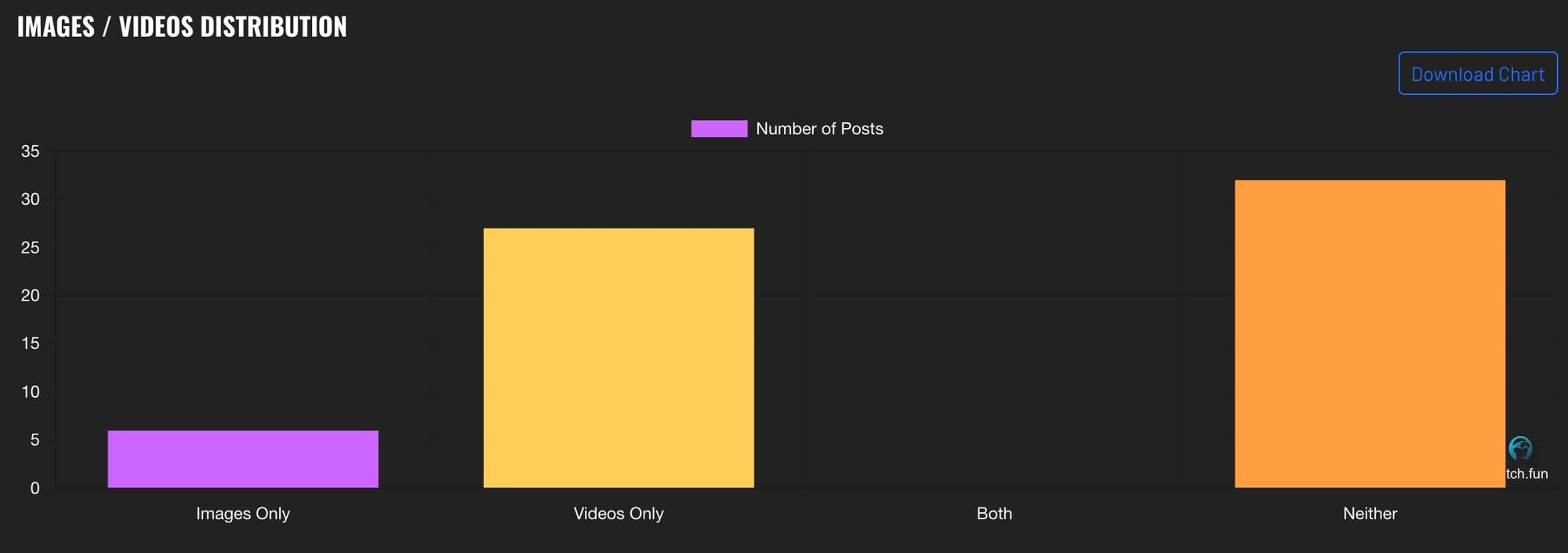


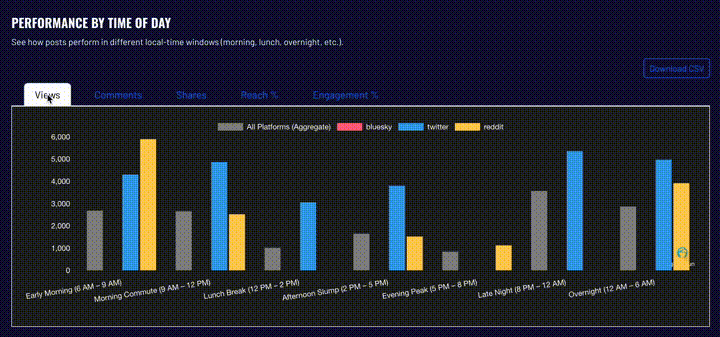

Adjusting Your Cadence
One last important point is that you do not have to keep the same cadence for the entire development process of your game. Once you have done this testing and understand your audience and what works for them, you can switch to a different posting rhythm based on your stage. Check the chart below to see how the amount of content you should post can vary depending on where you are in development.
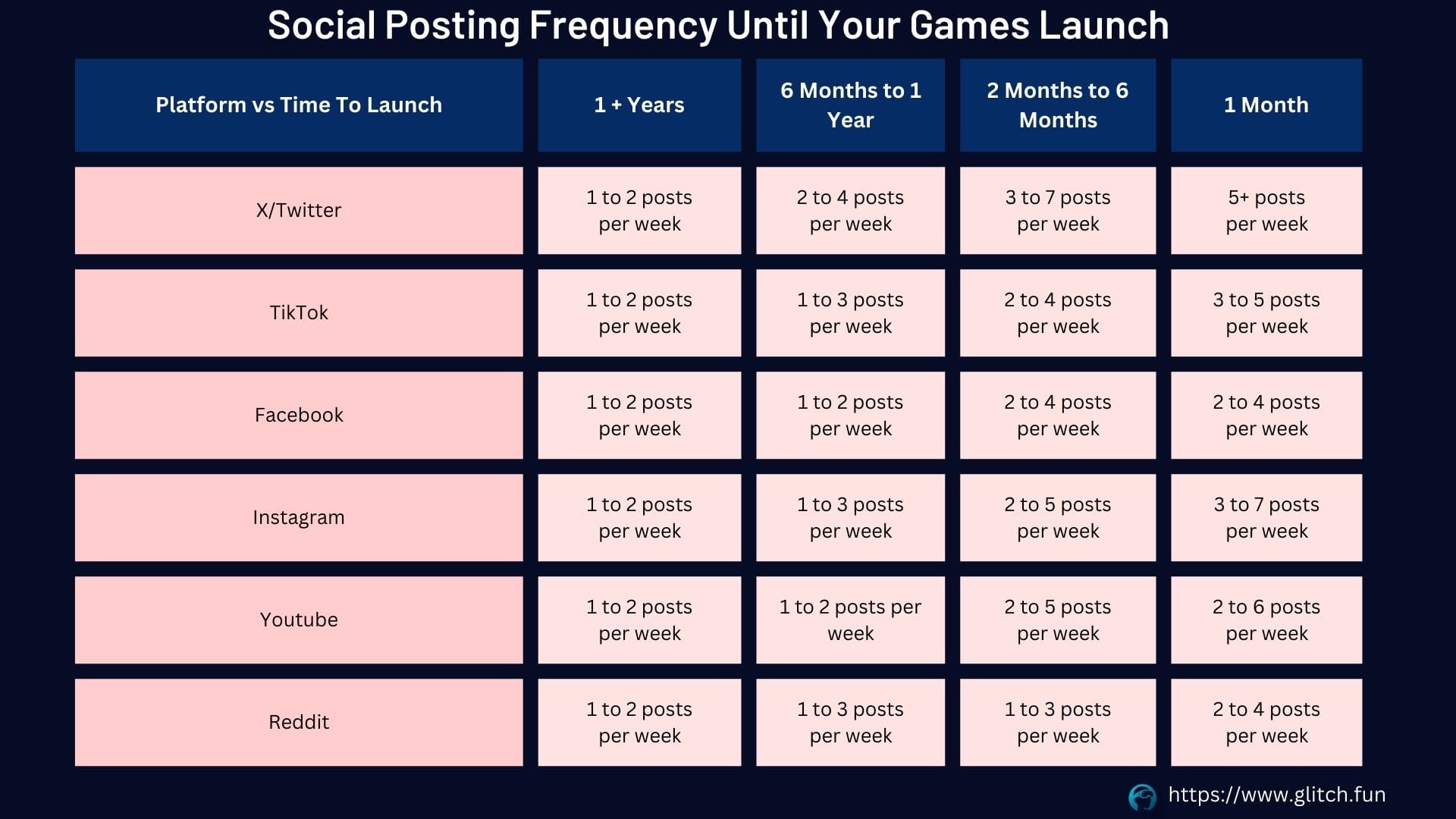
Following the guidelines to this chart and start after you have completed the above testing and optimization. Also, if you are very early in your development, like 2-3 years out and run these tests, you should re-run again when you are year out to re-evaluate your marketing as time has passed and your game has progressed.
Hard vs. Easy Way
The final piece of this article is about doing all of this the hard way versus the easy way. The “hard way” is handling everything in a very manual, low-tech manner, such as using spreadsheets. Spreadsheets can get the job done, but they often require much more of your time.
We offer a social media scheduler that automates much of the process for you. You can also use solutions like Hootsuite or Loomly. What differentiates our social media tool is that it ties your data directly to platforms like Steam, Epic, and Itch, allowing you to see how your efforts translate into wishlists and game sales—the bottom line for most developers.
Hopefully, reading this helps you understand why this cannot be done in a week. All these variations require time to test. In other articles, we will cover how to tie your social media growth into wishlist additions and sales.
By following these guidelines and consistently testing your content, emotional tone, audience targeting, timing, media type, calls to action, and each platform’s best practices, you will be well on your way to creating an organic social media strategy that drives real, long-term results for your game.


